初中英语动词时态讲解及练习
- 格式:doc
- 大小:134.50 KB
- 文档页数:17
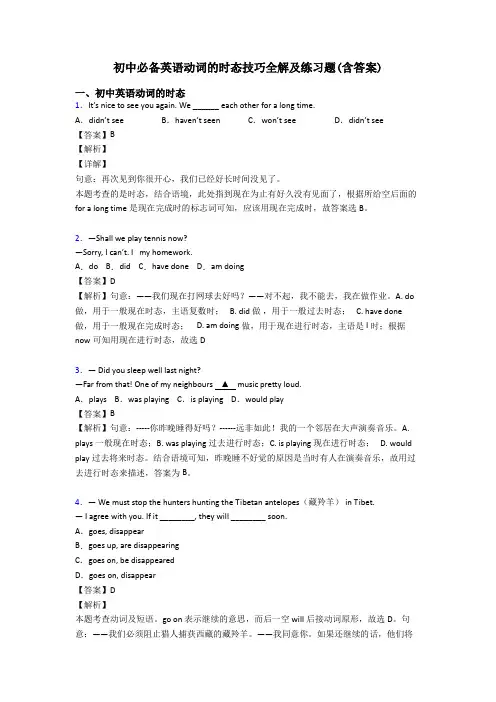
初中必备英语动词的时态技巧全解及练习题(含答案)一、初中英语动词的时态1.It’s nice to see you again. We ______ each other for a long time.A.didn’t see B.haven’t seen C.won’t see D.didn’t see【答案】B【解析】【详解】句意:再次见到你很开心,我们已经好长时间没见了。
本题考查的是时态,结合语境,此处指到现在为止有好久没有见面了,根据所给空后面的for a long time是现在完成时的标志词可知,应该用现在完成时,故答案选B。
2.—Shall we play tennis now?—Sorry, I can’t. I my homework.A.do B.did C.have done D.am doing【答案】D【解析】句意:——我们现在打网球去好吗?——对不起,我不能去,我在做作业。
A. do 做,用于一般现在时态,主语复数时; B. did做,用于一般过去时态; C. have done 做,用于一般现在完成时态; D. am doing做,用于现在进行时态,主语是I时;根据now可知用现在进行时态,故选D3.— Did you sleep well last night?—Far from that! One of my neighbours ▲ music pretty loud.A.plays B.was playing C.is playing D.would play【答案】B【解析】句意:-----你昨晚睡得好吗?------远非如此!我的一个邻居在大声演奏音乐。
A. plays一般现在时态;B. was playing 过去进行时态;C. is playing 现在进行时态; D. would play过去将来时态。
结合语境可知,昨晚睡不好觉的原因是当时有人在演奏音乐,故用过去进行时态来描述,答案为B。
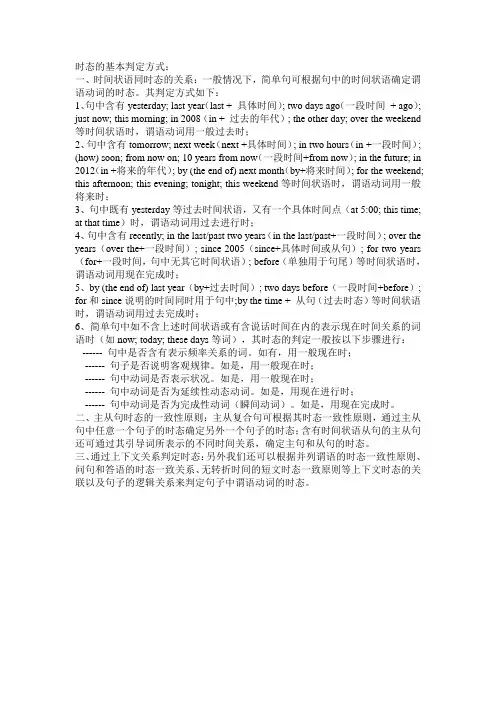
时态的基本判定方式:一、时间状语同时态的关系:一般情况下,简单句可根据句中的时间状语确定谓语动词的时态。
其判定方式如下:1、句中含有yesterday; last year(last + 具体时间); two days ago(一段时间+ ago); just now; this morning; in 2008(in + 过去的年代); the other day; over the weekend 等时间状语时,谓语动词用一般过去时;2、句中含有tomorrow; next week(next +具体时间); in two hours(in +一段时间); (how) soon; from now on; 10 years from now(一段时间+from now); in the future; in 2012(in +将来的年代); by (the end of) next month(by+将来时间); for the weekend; this afternoon; this evening; tonight; this weekend等时间状语时,谓语动词用一般将来时;3、句中既有yesterday等过去时间状语,又有一个具体时间点(at 5:00; this time; at that time)时,谓语动词用过去进行时;4、句中含有recently; in the last/past two years(in the last/past+一段时间); over the years(over the+一段时间); since 2005(since+具体时间或从句); for two years (for+一段时间,句中无其它时间状语); before(单独用于句尾)等时间状语时,谓语动词用现在完成时;5、by (the end of) last year(by+过去时间); two days before(一段时间+before); for和since说明的时间同时用于句中;by the time + 从句(过去时态)等时间状语时,谓语动词用过去完成时;6、简单句中如不含上述时间状语或有含说话时间在内的表示现在时间关系的词语时(如now; today; these days等词),其时态的判定一般按以下步骤进行:------ 句中是否含有表示频率关系的词。
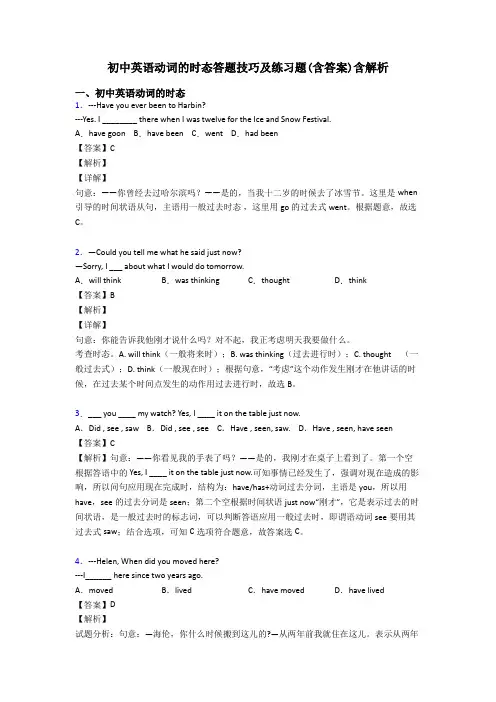
初中英语动词的时态答题技巧及练习题(含答案)含解析一、初中英语动词的时态1.---Have you ever been to Harbin?---Yes. I ________ there when I was twelve for the Ice and Snow Festival.A.have goon B.have been C.went D.had been【答案】C【解析】【详解】句意:——你曾经去过哈尔滨吗?——是的,当我十二岁的时候去了冰雪节。
这里是when 引导的时间状语从句,主语用一般过去时态,这里用go的过去式went。
根据题意,故选C。
2.—Could you tell me what he said just now?—Sorry, I ___ about what I would do tomorrow.A.will think B.was thinking C.thought D.think【答案】B【解析】【详解】句意:你能告诉我他刚才说什么吗?对不起,我正考虑明天我要做什么。
考查时态。
A. will think(一般将来时);B. was thinking(过去进行时);C. thought (一般过去式);D. think(一般现在时);根据句意,“考虑”这个动作发生刚才在他讲话的时候,在过去某个时间点发生的动作用过去进行时,故选B。
3.___ you ____ my watch? Yes, I ____ it on the table just now.A.Did , see , saw B.Did , see , see C.Have , seen, saw. D.Have , seen, have seen【答案】C【解析】句意:——你看见我的手表了吗?——是的,我刚才在桌子上看到了。
第一个空根据答语中的Yes, I ____ it on the table just now.可知事情已经发生了,强调对现在造成的影响,所以问句应用现在完成时,结构为:have/has+动词过去分词,主语是you,所以用have,see的过去分词是seen;第二个空根据时间状语just now“刚才”,它是表示过去的时间状语,是一般过去时的标志词,可以判断答语应用一般过去时,即谓语动词see要用其过去式saw;结合选项,可知C选项符合题意,故答案选C。

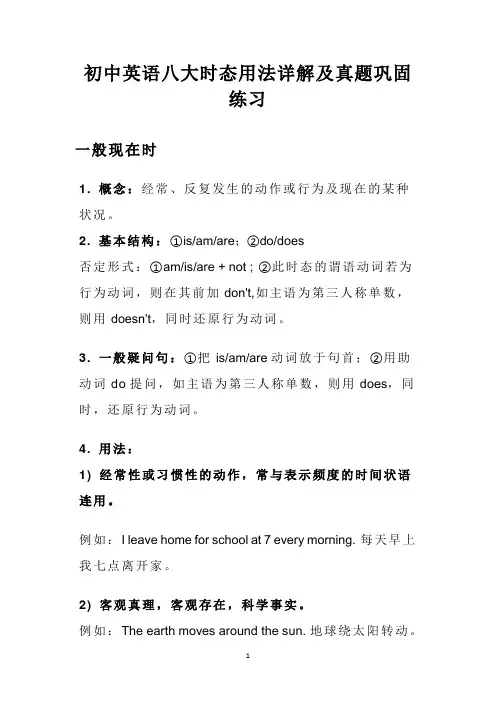
初中英语八大时态用法详解及真题巩固练习一般现在时1. 概念:经常、反复发生的动作或行为及现在的某种状况。
2. 基本结构:①is/am/are;②do/does否定形式:①am/is/are + not ; ②此时态的谓语动词若为行为动词,则在其前加don't,如主语为第三人称单数,则用doesn't,同时还原行为动词。
3. 一般疑问句:①把 is/am/are 动词放于句首;②用助动词do提问,如主语为第三人称单数,则用does,同时,还原行为动词。
4. 用法:1) 经常性或习惯性的动作,常与表示频度的时间状语连用。
例如:I leave home for school at 7 every morning. 每天早上我七点离开家。
2) 客观真理,客观存在,科学事实。
例如:The earth moves around the sun. 地球绕太阳转动。
Shanghai lies in the east of China. 上海位于中国东部。
3) 表示格言或警句。
例如:Pride goes before a fall. 骄者必败。
注意:此用法如果出现在宾语从句中,即使主句是过去时,从句谓语也要用一般现在时。
例如:I knew that the earth goes around the sun when I was little.我小时候就知道地球绕太阳转。
4) 现在时刻的状态、能力、性格、个性。
例如:I don't want so much. 我不要那么多。
Ann writes good English but does not speak well.安英语写得不错,讲的可不行。
5) 一般现在时表示将来含义a. 下列动词 come, go, arrive, leave, start, begin, return 的一般现在时可以表示将来,主要用来表示在时间上已确定或安排好的事情。
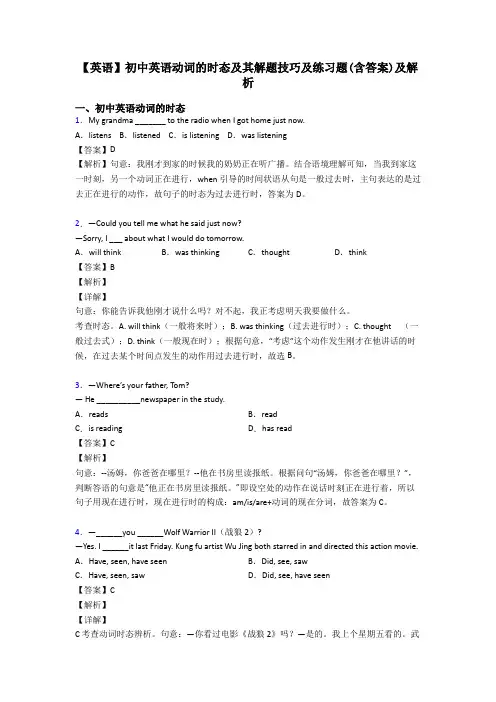
【英语】初中英语动词的时态及其解题技巧及练习题(含答案)及解析一、初中英语动词的时态1.My grandma _______ to the radio when I got home just now.A.listens B.listened C.is listening D.was listening【答案】D【解析】句意:我刚才到家的时候我的奶奶正在听广播。
结合语境理解可知,当我到家这一时刻,另一个动词正在进行,when引导的时间状语从句是一般过去时,主句表达的是过去正在进行的动作,故句子的时态为过去进行时,答案为D。
2.—Could you tell me what he said just now?—Sorry, I ___ about what I would do tomorrow.A.will think B.was thinking C.thought D.think【答案】B【解析】【详解】句意:你能告诉我他刚才说什么吗?对不起,我正考虑明天我要做什么。
考查时态。
A. will think(一般将来时);B. was thinking(过去进行时);C. thought (一般过去式);D. think(一般现在时);根据句意,“考虑”这个动作发生刚才在他讲话的时候,在过去某个时间点发生的动作用过去进行时,故选B。
3.—Where’s your father, Tom?— He __________newspaper in the study.A.reads B.readC.is reading D.has read【答案】C【解析】句意:--汤姆,你爸爸在哪里?--他在书房里读报纸。
根据问句“汤姆,你爸爸在哪里?”,判断答语的句意是“他正在书房里读报纸。
”即设空处的动作在说话时刻正在进行着,所以句子用现在进行时,现在进行时的构成:am/is/are+动词的现在分词,故答案为C。
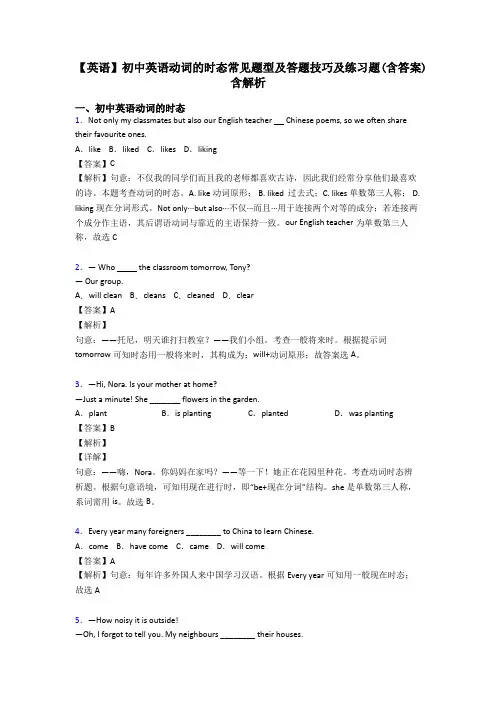
【英语】初中英语动词的时态常见题型及答题技巧及练习题(含答案)含解析一、初中英语动词的时态1.Not only my classmates but also our English teacher Chinese poems, so we often share their favourite ones.A.like B.liked C.likes D.liking【答案】C【解析】句意:不仅我的同学们而且我的老师都喜欢古诗,因此我们经常分享他们最喜欢的诗。
本题考查动词的时态。
A. like动词原形; B. liked 过去式;C. likes 单数第三人称; D. liking现在分词形式。
Not only···but also···不仅···而且···用于连接两个对等的成分;若连接两个成分作主语,其后谓语动词与靠近的主语保持一致。
our English teacher为单数第三人称,故选C2.— Who the classroom tomorrow, Tony?— Our group.A.will clean B.cleans C.cleaned D.clear【答案】A【解析】句意:——托尼,明天谁打扫教室?——我们小组。
考查一般将来时。
根据提示词tomorrow可知时态用一般将来时,其构成为:will+动词原形;故答案选A。
3.—Hi, Nora. Is your mother at home?—Just a minute! She _______ flowers in the garden.A.plant B.is planting C.planted D.was planting【答案】B【解析】【详解】句意:——嗨,Nora。
你妈妈在家吗?——等一下!她正在花园里种花。

英语语法八大时态一.一般现在时结构肯定句式: 主语+动词原形/动词的第三人称单数+其他否定句式: 主语+(助动词)don't/doesn't +动词原形+其他一般疑问句式: Do/Does+主语+动词原形+其他简略回答: (肯)Yes,主语+do/does (否)No,主语+do/does not缩写形式: don't = do not doesn't = does not例句:He often goes swimming in summer.I usually leave home for school at 7 every morning.二.一般过去时态结构肯定句式: 主语+动词过去式+其他否定句式: 主语+(助动词)didn’t +动词原形+其他一般疑问句式: Did+主语+动词原形+其他基本结构否定句一般疑问句Be动词was/were+not was/were提前,放于句首行为动词didn’t+do(动词原形)Did+主语+do(动词原形)三.一般将来时结构结构1:肯定句式:主语+助动词will+动词原形+其他否定句式:主语+助动词will+动词原形+not+其他一般疑问句式:助动词Will+主语+动词原形+其他简单回答:在口语中,will在名词或代词后常缩为’ll,wii not常简缩为won’t。
在疑问句中,主语为第一人称时(I和we)时,常用助动词shall。
例如:She’ll go to play basketball.Shall we go to the zoo?结构2:肯定句式:主语+be going to +动词原形+其他否定句式:主语+be not going to +动词原形+其他一般疑问句式:Be+主语+going to+动词原形+其他简略回答:(肯)Yes,主语+be (否)No,主语+be not将来时其他表示法1)be going to表示将来表示说话人的打算、计划、安排或根据迹象判断必然或很可能发生的事情。
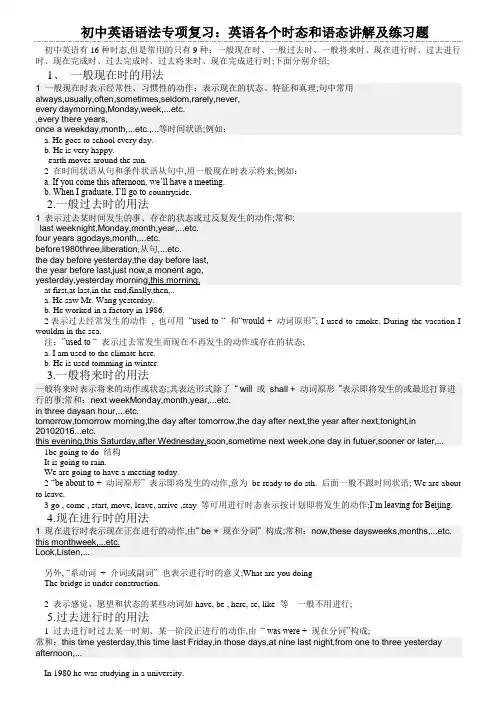
初中英语语法专项复习:英语各个时态和语态讲解及练习题初中英语有16种时态,但是常用的只有9种:一般现在时、一般过去时、一般将来时、现在进行时、过去进行时、现在完成时、过去完成时、过去将来时、现在完成进行时;下面分别介绍;1、一般现在时的用法1 一般现在时表示经常性、习惯性的动作;表示现在的状态、特征和真理;句中常用always,usually,often,sometimes,seldom,rarely,never,every daymorning,Monday,week,...etc.,every there years,once a weekday,month,...etc.,...等时间状语;例如:a. He goes to school every day.b. He is very happy.earth moves around the sun.2 在时间状语从句和条件状语从句中,用一般现在时表示将来;例如:a. If you come this afternoon, we’ll have a meeting.b. When I graduate, I’ll go to countryside.2.一般过去时的用法1 表示过去某时间发生的事、存在的状态或过反复发生的动作;常和:last weeknight,Monday,month,year,...etc.four years agodays,month,...etc.before1980three,liberation,从句,...etc.the day before yesterday,the day before last,the year before last,just now,a monent ago,yesterday,yesterday morning,this morning,at first,at last,in the end,finally,then,..a. He saw Mr. Wang yesterday.b. He worked in a factory in 1986.2表示过去经常发生的动作, 也可用“used to “ 和“would + 动词原形”; I used to smoke. During the vacation I wouldm in the sea.注:”used to “ 表示过去常发生而现在不再发生的动作或存在的状态;a. I am used to the climate here.b. He is used tomming in winter.3.一般将来时的用法一般将来时表示将来的动作或状态;其表达形式除了“ will 或shall + 动词原形”表示即将发生的或最近打算进行的事;常和:next weekMonday,month,year,...etc.in three daysan hour,...etc.tomorrow,tomorrow morning,the day after tomorrow,the day after next,the year after next,tonight,in 20102016...etc.this evening,this Saturday,after Wednesday,soon,sometime next week,one day in futuer,sooner or later,...1be going to do 结构It is going to rain.We are going to have a meeting today.2 “be about to + 动词原形” 表示即将发生的动作,意为be ready to do sth. 后面一般不跟时间状语; We are about to leave.3 go , come , start, move, leave, arrive ,stay 等可用进行时态表示按计划即将发生的动作;I’m leaving for Beijing.4.现在进行时的用法1 现在进行时表示现在正在进行的动作,由“ be + 现在分词” 构成;常和:now,these daysweeks,months,...etc. this monthweek,...etc.Look,Listen,...另外, “系动词+ 介词或副词” 也表示进行时的意义;What are you doingThe bridge is under construction.2 表示感觉、愿望和状态的某些动词如have, be , here, se, like 等一般不用进行;5.过去进行时的用法1 过去进行时过去某一时刻、某一阶段正进行的动作,由“ was were + 现在分词”构成;常和:this time yesterday,this time last Friday,in those days,at nine last night,from one to three yesterday afternoon,...In 1980 he was studying in a university.He was reading a novel when I came in.6.现在完成时的用法现在完成时由“have/has + 过去分词.其使用有两种情况:1 现在完成时所表示的动作在说话之前已完成,但对现在有影响;句中没有具体时间状语;常和:just,alreadly,yet,never,ever,now,before,this week,today,these days,once,twice,three times,...He has gone to Fuzhou.He has been to Fuzhou.2 现在完成时所表示的动作开始于过去,持续到现在,也许还会持续下去常用for 和since表示一段时间的状语或since then1949,last Monday,two o'clock,从句...,etc.,ever since then,for three daysa long time,two hours,...etc.so far , now, today, this wek month, year 等表示包括现在内的状语;He has studied English for 5 years.He has studied English since 1985.Now I have finished the work..注意:表示短暂时间动作的词如come, go , die, marry, buy 等的完成时不能与for, since 等表示一般时间的词连用;正确:I have bought the book already.错误:I have bought the book for two years.改:I have had the bookl for two years.7.过去完成时的用法1 过去完成时由“had + 过去分词”构成;过去完成时的动作表示过去某一时刻或某一时刻或某一动作之前完成的动作或状态;句中常用by then1977,yesterday,eight last night,the time we got there,...etc.by the end of last termweek,year,month,...etc..by, before, until, when 等词引导的时间状语;By the end of last year we had built five new houses.I had learnt 5000 words before I entered the university.2过去完成时的动词还可表示过去某一时刻之前发生的动作或状态持续到过去某个时间或持续下去;Before he slept, he had worked for 12 hours.8.过去将来时的用法过去将来时表示从过去的某个时间看来将要发生的动作或存在的状态;过去将来时由“should 或would + 动词原形” 构成;第一人称用should, 其他人称用would. ;常和:They were sure that they would succeed.二动词语态1.当句子的主语是动作的执行者时, 谓语的形式叫主动语态;句子的主语是动作承受者时,谓语的形式叫被动作语态;被动语态由助动词be + 过去分词构成,时态通过be 表现出来;1 一般现在时:You are required to do this.2 一般过去时:The story was told by her.3 一般将来时:The problem will be discussed tomorrow.4 现在进行时:The road is being widened.5 过去进行时:The new tool was being made.6 现在完成时:The novel has been read.7 过去完成时:He said that the work had been finished.8 过去将来时:He said that the trees would be planted soon.2. 一些特殊的被动结构1 带情态动词的被动结构:The problem must be solved soon.2 带不定式的被动结构:The room is going to be painted.The homework needs to be done with care.3 短语动词的被动:a.不及物动词+介词:若这类短语动词是及物性的,则可用于被动语态中,如:laugh at, look after, talk about, think of 等;若这类短语动词是不及物性的则不可用于被动语态中,如:book up, look down. 等b.及物动词+副词:bring about, carry out, find out, make out, put away, put off, take up, turn down, turn out, wipe out 等c. 动词+副词+介词:do away with, face up to, give into ,look down upon, make up with等d. 动词+名词+介词:catch sight of, keep on eye on, make a fool of , pay attention to , put an end to , set fire/light to , take notice of 等4 带复合宾语的动词在改为被动语态时,一般把主动结构中的宾语改为主语,宾语补足语保留在谓语后面;We always keep the classroom clean.比较:The classroom is always kept clean.5主动形式表示被动意义的词;常见的有:a.主动形式,这时动名词同句中的主语有动宾关系;The children need looking after.The windows wants /requires repairing.This point deserves mentioning.练习题1. It is a fine day. The sun __________shine brightly.2. They ___________visit the Science Museum next Sunday.3. Mr Brown________live in Beijing since he came to China.4. Mr Wang ________teach us English two years ago.5. The Smiths _______________ watch TV at this time last night.6. We __________learn about ten English songs by the end of last term.7. Father said that he ____________buy a new bike for me the next Friday.8. Bill isn¡¯t here. He ___________chat with his friends in the classroom.9. The teacher said that the moon __________go round the earth.10. The Young Pioneers will go to the zoo if it ____________not rain this Sunday.11. Listen They __________talk about the new film.12. Jim asked us what ___________happen in China in 1976.13. My mobile phone ___________steal on a bus last week.14. The host ____________interview the little boy just now.15. The Greens __________watch TV now.16. He said that he _____________ring me up when he got there.17. We ____________learn English for about three years.18. My brother_____________join the League in 1997.19. The farmers __________pick apples when I saw them.20. The red skirt __________cost the girl forty yuan.21. The film ____________begin when I got to the cinema.22. The girl told me that she wanted to be an English teacher when she _____grow up.23. My sister is a student and she _____________study at a middle school nearby.24. Mr Green __________travel to several places in South China since he came here.25. You _________catch the early bus if you get up early.26. _______you been________wear glasses all the time27. I’ll go home as soon as I _______finish my homework.29. Most science books are ______write in English.30. I ____________stay there for two months last year.31. Tell Lily to call me as soon as she _______.A. will arriveB. gets thereC. has goneD. reach here32. ----Hi, Kate. You look tired. What’s the matter ----I ______ well last night.A. didn’t sleepB. don’t sleepC. haven’t sleptD. won’t sleep33. ----Excuse me, look at the sign over there, please. Could you stop smoking----Sorry, I ____ that.A. didn’t seeB. don’t seeC. won’t seeD. can’t see34. ----Well, I found this. I think it must be yours. ----My watch Thank you. Where _____itA. do you findB. had you foundC. were you findingD. did you find35. ----Don you know when Dr White ____ for dinner this evening----No, but I think he ____ when he is free.A. will come; comesB. will come; will comeC. comes; comesD. comes; will come36. Look at those black clouds. It _____ rain. Let’s hurry. A. maybe B. would C. has D. is going to37. ----Jimmy is leaving for a holiday. ----Really Where ____ he ____A. has; goneB. will; goC. did; goD. does; go38. ----Shall we go shopping now ---Sorry, I can't. I ____ my shirts.A. washB. washesC. washedD. am washing39. ----I called you yesterday evening, but there was no answer.----Oh, I am sorry. I ___ dinner at my friend's home.A. haveB. hadC. was havingD. have had40. The Oriental Pearl TV Tower ____ thousands of visitors since 1995.A. attractedB. attractsC. has attractedD. will attract46. ----Why didn't you go to the cinema yesterday -----Because I ____ the film before.A. had seenB. have seenC. have watchedD. has watched47. I don't think John saw me. He ____ a book at that moment.A. just readB. has just readC. was just readingD. had just read48. Mr Smith ____ a book about China last year but I don't know whether he has finished it.A. has writtenB. wroteC. had writtenD. was writing49. Mr White ____ the newspaper while his daughter ____TV.A. has read; was watchingB. was reading; watchedC. was reading; was watchingD. reading; watched50. ---- I ____ you at the meeting. Why ----I was ill. A. saw B. have seen C. not see D. didn't see51. The 29th Olympic Games ____ in Beijing in 2008. A. hold B. will hold C. will be held D. held52. Hurry up The play ____ for ten minutes. A. has been on B. has begun C. had begun D. began53. ----May I speak to Mr Smith ----Sorry, he ____ Australia. But he ____ in two days.A. has been to; will come backB. has gone to; will be backC. has been in; would come backD. is leaving for; doesn't come back54. I can't go to the theater tonight because I ____ my ticket.A. have lostB. had lostC. will loseD. was losing55. ----What a nice bike How long ____ you ____ it ----Just two weeks.A. have; boughtB. did; buyC. have; hadD. are; having56. ----I'm sorry to have kept you waiting. ----Oh, not at all. I ____ here only for a few minutes.A. have comeB. had beenC. wasD. have been57. ----____ my dictionary anywhere ---- Yes. I saw it on your desk a moment ago.A. Did you seeB. If you seeC. Had you seenD. Would you see58. We were all surprised when he mad it clear that he ____ office soon.A. leavesB. would leaveC. will leaveD. had left答案:I. 1. shines/ is shining 2. are going to/ will visit 3. has lived 4. taught5. were watching6. had learned7. would buy8. is chatting9. goes 10.doesn't rain 11. are talking 12. happened 13. was stolen 14. interviewed15. are watching16. would ring 17. have learned 18. joined 19. were picking 20. cost21. had begun 22. grew 23. studies 24. has traveled 25. will catch26. Have; wearing 27. finish 28. haven't heard 29. written 30. stayedII. 31--35 BAADB 36--40 DBDCC 41--45 ACBAC 46--50 ACDCD51--55 CABAC 56--60 DABDA 61--65 BDBAB 66-70 BDABC 71--75 BCADD。
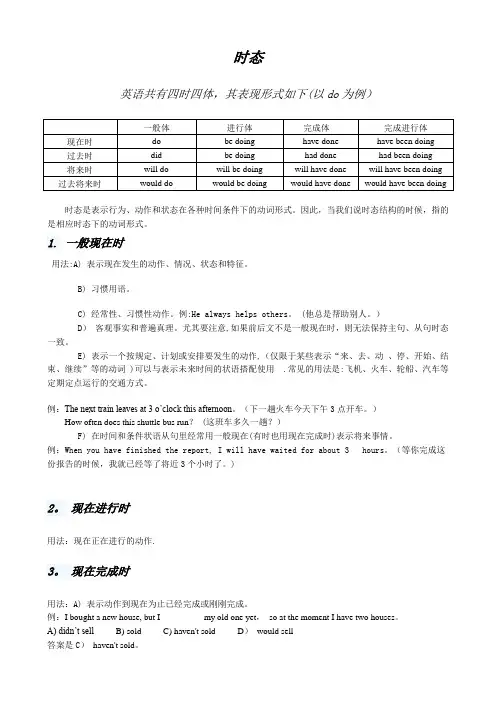
时态英语共有四时四体,其表现形式如下(以do为例)时态是表示行为、动作和状态在各种时间条件下的动词形式。
因此,当我们说时态结构的时候,指的是相应时态下的动词形式。
1. 一般现在时用法:A) 表示现在发生的动作、情况、状态和特征。
B) 习惯用语。
C) 经常性、习惯性动作。
例:He always helps others。
(他总是帮助别人。
)D)客观事实和普遍真理。
尤其要注意,如果前后文不是一般现在时,则无法保持主句、从句时态一致。
E) 表示一个按规定、计划或安排要发生的动作,(仅限于某些表示“来、去、动、停、开始、结束、继续”等的动词 )可以与表示未来时间的状语搭配使用.常见的用法是:飞机、火车、轮船、汽车等定期定点运行的交通方式。
例:The next train leaves at 3 o’clock this afternoon。
(下一趟火车今天下午3点开车。
)How often does this shuttle bus run? (这班车多久一趟?)F) 在时间和条件状语从句里经常用一般现在(有时也用现在完成时)表示将来事情。
例:When you have finished the report, I will have waited for about 3 hours。
(等你完成这份报告的时候,我就已经等了将近3个小时了。
)2。
现在进行时用法:现在正在进行的动作.3。
现在完成时用法:A) 表示动作到现在为止已经完成或刚刚完成。
例:I bought a new house, but I _________ my old one yet,so at the moment I have two houses。
A) didn’t sell B) sold C) haven't sold D)would sell答案是C)haven't sold。
B) 表示从过去某时刻开始,持续到现在的动作或情况,并且有可能会继续延续下去。
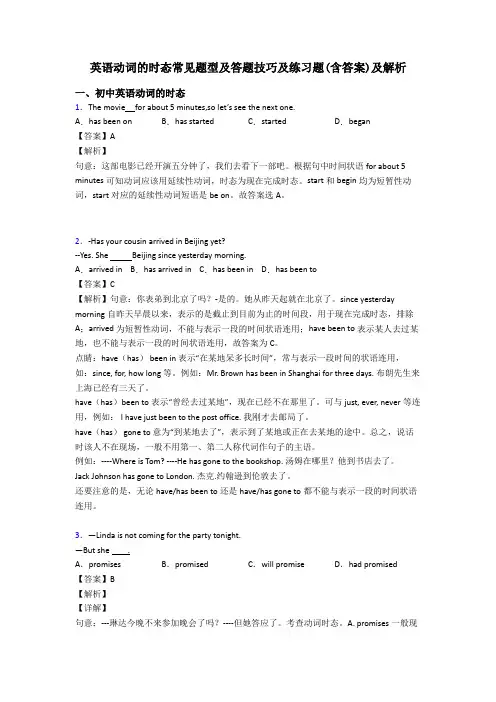
初中英语语法:动词八种时态、被动语态详解练习及答案:一、初中英语被动语态用法小结[1]一、语态概述英语的语态是通过动词形式的变化表现出来的。
英语中有两种语态:主动语态和被动语态。
主动语态表示主语是动作的执行者。
例如:Many people speak Chinese.谓语:speak的动作是由主语many people来执行的.被动语态表示主语是动作的承受者,即行为动作的对象.例如:Chinese is spoken by many people。
英语English是动词speak的承受者。
二、被动语态的构成被动语态由“助动词be+及物动词的过去分词"构成。
人称、数和时态的变化是通过be的变化表现出来的。
现以speak为例说明被动语态在各种时态中的构成.一般现在时:am/is/are+spoken一般过去时:was/were+spoken一般将来时:will/shall be+spoken现在进行时:am/is/are being+spoken过去进行时:was/were being+spoken现在完成时:have/has been+spoken过去完成时:had been + spoken三、被动语态的用法(1)不知道或没有必要说明动作的执行者是谁。
例如:Some new computers were stolen last night.一些新电脑在昨晚被盗了.(不知道电脑是谁偷的)This bridge was founded in 1981。
这座桥竣工于1981年。
(2)强调动作的承受者,而不强调动作的执行者。
例如:The glass was broken by Mike.玻璃杯是迈克打破的。
This book was written by him.这本书是他写的.Your homework must be finished on time.你们的家庭作业必须及时完成。
四、主动语态变被动语态的方法(1)把主动语态的宾语变为被动语态的主语。
【英语】初中英语动词的时态解题技巧及练习题(含答案)及解析一、初中英语动词的时态1.—When did the classroom have a power cut?—This morning. While we ______ an English lesson.A.have B.had C.are having D.were having【答案】D【解析】句意:——教室什么时候停电的?——今天早上,当我们正在上英语课。
根据句中的This morning判断句子是一个过去的时间,时态用过去时;而While引导的句子通常用进行时,所以本句使用过去进行时,构成为were/was+动词现在分词,主语是we,所以系动词用were,have an English lesson“上英语课”,have的现在分词是having;故答案选D。
2.My mother when I got home yesterday.A.will cook B.cooks C.has cooked D.was cooking【答案】D【解析】句意:当我昨天回到家的时候,我的妈妈正在做饭。
考查的是过去进行时。
根据when引导的一般过去时的时间状语从句推断主句描述的是过去某个时间正在发生的动作,故用过去进行时态,过去进行时的构成是:主语+was/were+动词的现在分词,主语是第三人称单数所以be动词用was,cook的现在分词是cooking;故答案选D。
3.-Has your cousin arrived in Beijing yet?--Yes. She Beijing since yesterday morning.A.arrived in B.has arrived in C.has been in D.has been to【答案】C【解析】句意:你表弟到北京了吗?-是的。
她从昨天起就在北京了。
since yesterday morning自昨天早晨以来,表示的是截止到目前为止的时间段,用于现在完成时态,排除A;arrived为短暂性动词,不能与表示一段的时间状语连用;have been to表示某人去过某地,也不能与表示一段的时间状语连用,故答案为C。
初中英语语法:动词时态讲解及练习初中英语语法:动词时态讲解及练动词时态专讲一、概说动词的时态历来是中考题中考查的重头戏之一。
测试重点放在根据特定语言环境区别使用一般现在时,一般过去时和现在完成时;一般现在时(过去时)与现在(过去)进行时;特定的时间状语中时态的使用;结合所获得的语言知识确定正确时态的能力等。
综上所述,动词的时态在中考测试中的地位非常重要。
因而考生在复备考中必须对本专题引起足够的重视。
构成时态二、各种时态的构成do / does一般现在时时态构成did一般过去时am / is / arewas / were现在完成时现在进行时一般将来时am / is / are + doinghave / has + doneshall / will + do曩昔完成时过去进行时过去将来时was / were + doingwould + dohad + donewas / were going + to doam / is / are going + to do普通目前时三、各种时态的用法1.透露表现经常性或气性的举措,常与透露表现频度的工夫状语连用。
时间状语:every day,every other day,sometimes,often,usually,on Sunday …I leave home for school at 7 _________________ (天天清晨).The Olympic Games are held ____________________ (每四年).What do you ____________ (平日) do when you are free on Sunday?2.用在客观真理,客观存在,科学事实或格言警句中。
The earth _________________ (绕着……转) the sun.Shanghai lies in the east of China.上海__________中国的东方。
中考英语动词的时态答题技巧及练习题(含答案)一、初中英语动词的时态1.I _______ him the good news as soon as he _______ back.A.will tell, comes B.told, comesC.will tell, will come D.tell, come【答案】A【解析】句意:他一回来,我就告诉他这个好消息。
as soon as“一……就……”,引导的时间状语从句,用一般现在时,主句用一般将来时。
第二空主语he是第三人称单数,故谓语用第三人称单数comes。
故选A。
2.Miss Smith in our school since five years ago.A.teaches B.taught C.has taught D.is teaching【答案】C【解析】句意:Smith小姐从5年前就已经在我们学校教书了。
考查现在完成时。
since five years ago自从五年前以来,意为自从五年前以来他就教我们英语,表示状态的持续,用于现在完成时;现在完成时的构成:主语+have/has+动词过去分词;主语是Miss Smith,所以助动词用has,teach教,实义动词,过去分词是taught,故答案选C。
3.—There are so many swimmers swimming in the swimming pool.—Yes, and sixty percent _ children.A.is B.are C.was D.were【答案】B【解析】句意:——在游泳池里有那么多游泳者正在游泳。
——是的,而且百分之六十是孩子。
根据谓语are可知此处用一般现在时,故排除CD两项。
此处的sixty percent代指的是百分之六十的游泳者,故谓语用复数形式,故选B。
4.—I ________ you at seven and you didn’t pick up.—I was taking a shower at that time.A.call B.calledC.am calling D.have called【答案】B【解析】句意:——我七点钟打电话给你,你没接。
【英语】中考英语动词的时态解题技巧及经典题型及练习题(含答案)一、初中英语动词的时态1.―When did she leave? ―As if it was 3:30. She for about 2 hours.A.has been away B.left C.has left【答案】A【解析】句意:―她什么时候离开的?―好像在3:30。
她离开了大约2个小时。
根据for about 2 hours.可知句中谓语动词必须是延续性动词,而且用现在完成时。
所以选A。
点睛:短暂性动词在现在完成时态的肯定句中不能与表示一段的时间状语连用,如句子中的left为短暂性动词,另外还要记住几个常见的短暂性动词与延续性动词的转化:borrow→keep, buy→have, get/catch a cold→have a cold ,die→be dead, open→be open,end/finish → be over,begin/start→ be on, leave→be away, come→be in/here等。
如:His father died 10 years ago.=His father has been dead for 10 years。
I bought this pen 3 years ago. = I have had this pen for 3 years.2.Her son Coke, but now he milk.A.used to drink; is used to drinking B.used to drinking; drinksC.is used to drinking; used to drink D.was used to drink; is drinking【答案】A【解析】【详解】句意:她儿子过去常喝可乐,但现在他习惯喝牛奶。
used to do过去常常做;be used to doing sth习惯于做某事;drinks喝,第三人称单数形式;is drinking现在进行时,根据转折词but,可知前句表示过去喝可乐,后句表示习惯于喝牛奶,故选A。
初中英语语法:八种时态详解与练习一.概念:英语中表示不同时间发生的动作或存在的状态,需用不同的动词形式表示, 这种不同的动词形式称为时态;二.种类:基本时态一般现在时一般过去时现在进行时过去进行时一般将来时过去将来时现在完成时过去完成时一般现在时一、概念:经常、反复发生的动作或行为及现在的某种状况;二、常搭配的时间状语:always, usually, often, sometimes, every week day, year, month, once a week,on Sundays, etc.三、基本结构①be动词is,am,are;②行为动词主语是第三人称单数时谓语动词要加s或es外否定形式:①am/is/are+not;②此时态的谓语动词若为行为动词,则在其前加don't,如主语为第三人称单数,则用doesn't,同时还原行为动词;一般疑问句:①把be动词放于句首;②用助动词do提问,如主语为第三人称单数,则用does,同时,还原行为动词;例句:I go to school at 6 every morning. 每天早上我七点去上学;Summer follows spring. 春天之后是夏天;I learned that the earth goes around the sun when I was in primary school. 我在小学就学过地球是围绕太阳转的;Pride goes before a fall. 骄者必败;四、基本用法:1 描述当前时间内经常出现、反复发生的动作或存在的状态;在这种情景中,句子常带有表示频率的时间状语:always , everyday , often , once a week month , year , etc. , sometimes , seldom , usually等等,以表示句中的动作或状态是习惯性的、经常性的;例如:They raise ducks as a sideline .他们以养鸭为副业;She doesn't often write to her family, only once a month. 她不常给家里写信,仅一月一封而已;I cycle to work every day .我每天骑自行车上班;It seldom rains here .这儿很少下雨;2仅为了描述状态、性质、特征、能力等等;这里的目的是为了"描述现阶段的动作或状态",其重点"不是强调动作发生的时间、或进行的状态";例如:He can speak five foreign languages .他能说五种外语;That is a beautiful city .那是座美丽的城市;Changjiang River is one of the longest rivers in the world. 长江是世界上最长河流之一;She majors in music .她主修音乐;All my family love football .我全家人都喜欢足球;强调每个家人My sister is always ready to help others . 我妹妹总是乐于助人;3 陈述客观事实、客观真理;顾名思义,客观的情况是"没有时间概念"的;也"不会在意动作进行的状态";例如:The earth goes around the sun .地球绕着太阳转;Ten minus two is eight.十减二等于八;Light travels faster than sound .光的速度比声音的速度快;The United States lies by the west coast of the Pacific Ocean. 美国位于太平洋西岸;4 根据英文语法规定,当主句的谓语动词是一般将来时,那么时间或条件状语从句的谓语动词只能用一般现在时来表示将来要发生的动作;例如:I'll tell him the news when he comes back. 他回来时,我将告诉他这个消息;If you take the job , they will talk with you in greater details.如果你接受这份工作,他们将和你谈谈细节;用于一般现在时的副词,除了上面提到的一些表示频率的词以外,常见的还有:now, today , nowadays等等;练习题:用动词的适当形式填空:absent today begoto school at seven in the morning.mother________like ______go shopping.can ________draw many beautiful pictures.he_________like_________jumpstudents___________speak English in class.student_________speak Chinese after class.8. Let's____________and play football . go9. He_____________ like swimming . not10. __________your sister study English at school No , she__________ . do用所给动词的适当形式填空:1.I ______________write to you as soon as I _______get to London.2. He doesn't feel well and ____________not eat any food this morning.3. He ______ not _______see me come in, for he ___________read something with great interest.4. Don't make a niose. Grandpa __________sleep.5. It ________take me two hours to finish my homework last night.6. What ______ your mother _______do at eight yesterday evening She _______wash clothes.7. _______ it _________ rain when school was over yesterday8 The teacher told us the earth __________ move round the sun.单项选择:students will go to the Summer Palace if it _____ tomorrow.'t rain B. doesn't rain C. won't rain3. The picture _______ nice.looked looking4. She ______ down and soon fell asleep. A. live B. lain C. laid D. lay6. We shall go to Shanghai on business before you _____ back next week.A. wil comeB. cameC. would comeD. come7. Don't smoke until the plane ______ off. taken take8. I saw her ____ the room this morning. enter B. entered C. enter D. enters11. He told us ______ at eight. A. working B. to work C. work D. worked12. You'd better ______ at home and ______ your homework.A. to stay, doB. stay, doC. to stay, to doD. stay, to do14. Uncle Wang knows _______ a washing machine.A. how to makeB. to makeC. how makingD. what to make15. Jim decided _______ Polly to Ling Feng when he was back to England.A. to leaveB. leftC. leavingD. leave4改句子1. We have four lessons.否定句have many books. 改为否定句Shan's sister likes playing table tennis 改为否定句lives in a small town near New York. 改为一般疑问句watch TV every day. 改为一般疑问句has got a goal. 改为一般疑问句have four lessons.否定句does his homework at home. 否定句: 一般疑问句: 划线提问usually play football on Friday afternoon. 否定句: 一般疑问句: 划线提问一般过去时一、概念:过去某个时间里发生的动作或状态;过去习惯性、经常性的动作、行为;二、常搭配的时间状语:ago, yesterday, the day before yesterday, last weekyear, night, month, in 1989, just now, at the age of 5, one day, long long ago, once upon a time, etc.三、基本结构:①be动词的过去式was/were;②行为动词的过去式即在动词原形后加ed,不规则变化的动词除外否定形式:①was/were+not;②在行为动词前加didn't,同时还原行为动词;一般疑问句:①was或were放于句首;②用助动词do的过去式did 提问,同时还原行为动词;一般过去时用谓语动词的过去式构成,即在动词原形后加ed,不规则变化的特殊动词除外;例句:He was here just now. 他刚才还在这里;What did you do yesterday 你昨天做了什么事We often played together when we were children. 我们小时候常在一起玩;He used to smoke a lot, but he doesn’t now. 他过去经常抽烟,但现在不抽了;四、基本用法主要是用来描述在过去某个时候发生的动作或存在的状态;它也可以用来表示在过去某段时间里经常发生的习惯性动作;这一点在表达意义上与一般现在时相同,只是所在的时间区域不同而已;由于它的主要作用如此,所以在使用一般过去时的句子里常常有一个意义较具体的过去时间状语;这也是它与现在完成时的最大区别之一;常和一般过去时连用的过去时间状语有:last night week ,month , year , century , etc. , yesterday , the day before yesterday , yesterday morning afternoon , evening , in 1999 , two hours ago one week ago , tree years ago , …等等;使用一般过去时,在某种意义上说就是要强调动作或状态发生或存在于过去的某个时候;"过去"的时间概念有两层意思:一是指"现在某个时间"以前的时间;二是指"说话、写文章的那个时间点"以前的时间,在这个意义上,"现在的那个时间点"是很小很小的,甚至于小到无法量化的程度;例如:He got his driving license last month. 他上个月拿到了驾照;--Where's Jim 吉姆在哪里--He just went out.他刚刚出去;练习:写出下列动词的过去式is/am_________ fly_______ plant________ are ________ drink_________play_______ go________ make ________ do/does_________ worry________eat__________ draw________put ______ throw________ pass_______用be动词的适当形式填空1. The little dog _____ two years old this year.2. She _______ happy yesterday.3. They _______ glad to see each other last month.4. Today _____ the second of June. Yesterday ______ the first of June. It _____ Children's Day. All the students ______ very excited.句型变换:1 There was a car in front of the house just now.否定句:__________________________________________________________一般疑问句:__________________________________________________________ 肯定回答:__________________________________________________________否定回答:__________________________________________________________2 They played football in the playground.否定句:__________________________________________________________一般疑问句:__________________________________________________________ 肯定回答:__________________________________________________________否定回答:__________________________________________________________用所给动词的适当形式填空:1. I ______ watch a cartoon on Saturday.2. Her father _______ read a newspaper last night.3. It ____ be the 2nd of November yesterday. Mr White ___ go to his office by car.4. ______ you _______ visit your relatives last Spring Festival5. Gao Shan ________ put the book on his head a moment ago.6. Don't ______ the house. Mum _______ it yesterday. clean7. What _________ she _________ find in the garden last morningShe _________ find a beautiful butterfly.8. What _________ you ______ just now I _______ some housework. do9 We all _________ have a good time last night.10. She likes _________ newspapers, but she _________ a book yesterday. read11. He ___________ football now, but they _______ basketball just now. play句型转换:1、Lucy did her homework at home.改否定句Lucy ___________ ___________ her homework at home.2、He found some meat in the fridge冰箱.变一般疑问句___________ he __________ ___________ meat in the fridge3、She stayed there for a week.对划线部分提问__________ ___________ __________ she __________ there4、There was some orange in the cup.变一般疑问句_________ there ___________ orange in the cup中译英:1. 我过了一个忙碌但却刺激的周末;I _________ _________ __________ __________ exciting weekend.2 Jenny喜欢看书;昨晚她看了一本英语书;Jenny likes _________ __________. She _________ an English book last night.3. Emma每天都看电视;可是昨天他没有看;Emma __________ TV every day. But he _________ ___________ yesterday.4. 上周六他们做什么了他们做作业和购物了;What ________ they _________ _________ SaturdayThey _________ __________ homework and _________ __________.一般将来时一、概念:表示将要发生的动作或存在的状态及打算、计划或准备做某事;二、时间状语:tomorrow, next dayweek, month, year,soon, in a few minutes, by,the day after tomorrow, 等;三、基本结构①am/is/are/going to + do;②will/shall + do.否定形式:①was/were + not; ②在行为动词前加didn't,同时还原行为动词;一般疑问句:①be放于句首;②will/shall提到句首;如:Telephone me this evening. I’ll be at home. 今晚给我打电话,我会在家;I’ll shall/will do a better job next time. 下次我要干得好些;The car won’t start. 车开不了啦;Oil and water will not mix. 油和水没法混在一起;四、基本用法:主要用来描述将要发生的动作或存在于未来的情况;这里所说的“将来时间”是指“说话、写文章那一刻以后的时间”;它的表示方法主要有如下几种:1shall / will + 动词原形这种表示方法是说,动作在现在或目前还未发生,要在将来的某个时间内发生;它没有主观性,是“纯粹的将来动作”;例如:I shall / will not be free tomorrow .我明天没空;He will arrive here this evening .他今晚抵达这里;2 be am / is / are + going +不定式这种表示方法主要是说明A“说话人的意图、打算”;B“某种可能性”;例如:A He is going to spend his holidays in London . 他打算在伦敦度假;Who is going to speak first 谁先发言B It is going to rain soon .马上要下雨了;Is he going to collect any data for us 他会帮我们收集资料吗If you go to New Zealand, you are going to like the place. 如果你去新西兰,你会喜欢上那个地方的;3 be am / is / are + 不定式表示方法描述两钟情况:按计划安排要发生的动作,这个动作发生的时间一般不会很远;要求或命令他人做某事;例如:A The new bridge is to open to traffic in three days. 新桥三天后通车;The factory is to go into production before National Day. 这家工厂国庆节前投产;B You are not to bring any mobile communication means into the exam-room . 任何移动通讯工具都不得带入考场;You are to stay home until your mother comes back. 你妈回来之前你不要出去;4 用一般现在时或现在进行时限于某些动词表示按计划安排要发生的事;主要强调“按计划安排要发生的事”;例如:Do you get off at the next stop 你下一站下车吗The plane takes off at 11:00 . 那架飞机上午十一点起飞;Mr. Reider is leaving for New York next week. 里德先生下周动身去纽约;五、表示将来的五种常用非时态方式1. “be+不定式”:表示命令、安排、倾向或必须、义务等;如:She is to play Juliet. 她扮演朱丽叶;You are to make the necessary changes. 你要做出必要的改变;2. “be about to + 不定式”:表示即将发生的动作,有“即将”的意思,但不能和具体的时间状语连用;如:The package is about to come unwrapped. 那个包快散开了;3. “be going + 不定式”:表示按计划或安排打算去做某事,或表示有迹象表明要发生某事;如:We are going to call her this evening. 我们打算今晚给她打电话;My sister’s going to hav e a baby this summer. 我姐姐今年夏天要生孩子;4. 用现在进行时表示将来:主要表示按规定或时间预计要发生的事;如:The students are leaving on Sunday. 学生们星期日出发;We’re having a party next week. 我们下星期将开一个晚会;5. 用一般现在时表示将来:表示按规定或时间预计要发生的事;如:We have a holiday tomorrow. 我们明天放假;The train leaves at 10:04 this evening. 火车今晚10:04分开;练习一、单项选择1. There __________ a meeting tomorrow afternoon.A. will be going toB. will going to beC. is going to beD. will go to be2. Charlie ________ here next month.A. isn't workingB. doesn't workingC. isn't going to workingD. won't work3. He ________ very busy this week, he ________ free next week.A. will be; isB. is; isC. will be; will beD. is; will be4. ________ a concert next SaturdayA. There will beB. Will there beC. There can beD. There are5. If they come, we ________ a meeting.A. haveB. will haveC. hadD. would have6. He ________ to us as soon as he gets there.A. writesB. has writtenC. will writeD. wrote7. He ________ in three days.A. coming backB. came backC. will come backD. is going to coming back8. If it ________ tomorrow, we'll go roller-skating.A. isn't rainB. won't rainC. doesn't rainD. doesn't fine9. The day after tomorrow they ________ a volleyball match.A. will watchingB. watchesC. is watchingD. are going to watch10. He ________ there at ten tomorrow morning.A. willB. isC. will beD. be11. - Let's go out to play football, shall we - OK. I ________.A. will comingB. be going to comeC. comeD. am coming12. It ________ us a long time to learn English well.A. takesB. will takeC. spendsD. will spend13. The train ________ at 11.A. going to arriveB. will be arriveC. is going toD. is arriving二、用动词的适当形式填空1. I ______leavein a minute. I ______finishall my work before I ______ leave.2. Mary's birthday is next Monday, her mother _____giveher a present.3. -_____ you _____behere this Saturday-No. I ______visitmy teacher.4. -______ I ______getyou a copy of today's newspaper-Thank you.5. I am afraid there ______bea meeting this afternoon. I can't join you.过去将来时一、概念:立足于过去某一时刻,从过去看将来,常用于宾语从句中;二、常搭配的时间状语:the next daymorning, year,the following monthweek,etc.三、基本结构:①was/were going to + do;②would/should + do; ③was/were to was/were about to+do否定形式:①was/were/not + going to + do;②would/should + not + do.一般疑问句:①was或were放于句首;②would/should 提到句首;例句:I knew you would agree. 我知道你会同意的;I said I would arrange everything. 我说我来安排一切;四、基本用法表示过去的某时以后将要发生的动作;但这个"将来"时间绝不会延伸到“现在”;而仅限于“过去时间区域内”;由此可以看出,含这个时态的句子常带一个表示“过去某个时间点”的状语;这个状语或是一个短语,或是一个句子;这个时态常用于:A宾语从句或间接引语中;B表示过去习惯性的动作;C表示过去情况中的“愿望”、“倾向”,多用于否定句;例如:A When I thought about it , I wondered what their reaction would be . 当我考虑这件事时,我想知道他们的反应是什么;She told me that she would go on trip to Europe the next day. 她告诉我,她第二天要去欧洲旅行;He didn't expect that we would all be there. 他没料到我们会全在那儿;B During that period , he would do morning-exercises every day. 在那段时间,他每天早锻炼;Whenever he had time, he would help his mother with some housework. 无论他什么时间有空,他总是帮他妈妈干点家务活;C No matter how difficult the work was , he would keep on doing it until he accomplished it . 不管工作有多难,他总会坚持不懈地把它干完;They knew that we would never permit such a thing. 他们知道我们绝不会允许发生这样的事;Even after the lecture ended, the audience would not leave . 甚至在讲座结束之后,听众仍不肯离去;练习:I. 选择填空1. Li Ming said he _____happy if Brian_____to China next month.A. as; comeB. was; would comeC. would be; cameD. will be; come2. We were not sure whether they ______ more vegetables.A. are going to growB. were going to growC. will growD. have grown3. She ______ to work when the telephone rang.A. is goingB. will goC. was about to goD. is to goII. 用所给动词的适当形式填空1. Miss Zhang said she ________________visit the Great Wall next summer.2. She told him that she _____________not stay here for long.3. I wasn’t sure whether Lucy__________come the next year.4. She said the bus _______________leave at five the next morning.5. I wasn't sure whether he _______________lend me his book the next morning.6. He was fifty-six. In two years he _______be fifty-eight.现在进行时一、概念:表示现阶段或说话时正在进行的动作及行为;二、常搭配的时间状语:now, at this time, these days, etc.三、基本结构:am/is/are+动词的现在分词V-ing否定形式:am/is/are+not+doing.一般疑问句:把be动词放于句首;例:They’re having a meeting. 他们在开会;I’m studying at an evening school. 我在上夜校;You’re always interrupting me 你老打断我的话抱怨She’s always helping people. 她老是帮助别人;赞扬四、基本用法主要用来描述“说话、写文章的当刻”正在发生的动作,或是“现阶段”一直在进行的动作;适用于下面的情况:1“说话、写文章的当刻”正在发生的动作;例如:They are having a football match .他们正在赛足球;She is writing her term paper. 她正在写学期论文;Someone is asking for you on the phone. 有人找你听电话;2“现阶段”一直在进行的动作;这种情况并不是说某个动作在说话的那会儿正在发生,而是说某个动作在当前一段时间内一直在进行着,或是重复地发生着;例如:He is preparing for CET Band Six. 他在为大学英语六级考试作准备;How are you getting along with your new job 你那份新工作干得怎么样3表示说话人的情感,如:赞许、批评;喜欢、厌恶等;这时的动作并不是正在发生或进行,而是表示经常性,相当于“一般现在时”所描述的情况;例如:He is always thinking of others , not of himself . 表示赞许他总是为他人着想,而不为自己;She is often doing well at school. 表示满意她在学校学习挺不错的;Are you feeling better today 表示亲切你今天觉得好一些吗One of my roommates is constantly leaving things about.表示不满我的一个室友老是乱扔东西;Some sellers are often knocking at our door and promoting their products to us .表示不喜欢有些推销员老是敲我家的门,向我们推销他们的产品;4表示在近期按计划或安排要发生的动作,用于这种情况仅限于少量的动词,如:go , come , leave ,arrive , see , have , lunch 吃午饭, return, dine 进餐,尤指晚餐, work , sleep , stay , play , do , wear 穿,戴等;例如:I'm dinning out with my friends this evening. 今晚我将和朋友在外面吃饭;An American professor is giving a lecture this afternoon. 今天下午一位美国教授要来作报告;We are having a holiday next Wednesday. 下周三我们放假;Are you staying here till next week 你要在这儿呆到下星期吗练习:一、写出下列动词的现在分词:play______run__________swim________make_______write________ski_______have_______sing_______see_____buy______live_______take________get________stop________sit________二、用所给的动词的正确形式填空:1. Listen .Some girls __________ singin the classroom .2. My mother ____________ cook some nice food now.3. What _____ you ______ do now____________not ,water the flowers now.5. It's 5 o'clock now. We ___________havesupper nowwash clothes Yes ,she is三、句型转换:1.Tom is reading books in his room now . 对划线部分提问________________________________________________2. My mother is cooking some nice food now. 改一般疑问句并作肯定和否定回答①_______________________________________________②____________________________________③_____________________________四、填空题1.Mr Zheng _______________ read a book now.2. Listen Someone is__________________come.3. Look He _________ dive now.4. Tom __________________ watch TV in the dining room.5. Come on. They _________________ leave now.6. Where is your motherShe ________________________ answer the phone.do sing an English song.过去进行时一、概念:表示过去某段时间或某一时刻正在发生或进行的行为或动作;二、时间状语:at this time yesterday, at that time或以when引导的谓语动词是一般过去时的时间状语等;三、基本结构:was/were+动词的现在分词doing否定形式:was/were + not + doing.一般疑问句:把was或were放于句首;四、基本用法:主要表示在过去的某个时间点上正在发生、进行的动作;由于它的定义是表示在过去的某个时间点上正在发生、进行的动作,所以,句子常带有一个表示“过去某个时间点”的状语;这个状语可能是短语,词组,或是一个从句;也可能是通过上下文来表达这层意思;过去进行时主要用于下面的情景中:1表示在过去某时刻正在进行的动作,例如:At this moment yesterday, I was packing for camp.昨天这时候,我正在收拾东西去露营; When I came to see her last time, she was writing an article.上次我来看她的时候,她正在写一篇文章;What were you doing at eight last night 昨晚八点钟你在做什么2用于故事的开头,交代故事发生的背景情况;过去进行时所描述的动作是“正在进行”,所以,在这种情景中用“过去进行时”可以给读者一种“动感”,从而能使文章更加生动活泼;例如:One night, he was typing in his study . Suddenly , a man broke into his house and cut off the electricity … .一天晚上,他正在书房里打字;突然,一个人闯进屋来,切断了电源……3仅限少数动词表示在过去的未来时间要发生的动作;例如:When National Day was coming near , they began to make a plan for the holiday .国庆节即将来临的时候,他们开始制订度假计划;She told me that she was going to Hainan for her holiday. 她告诉我她将去海南度假;My friend said to me that he was lunching with one of his customers that day .我朋友对我说,他今天要与他的一位客户一块儿吃午饭;We left there when it's getting dark. 天快黑的时候,我们离开了那儿;五、过去进行时和一般过去时的区别两者的基本差别是过去进行时通常表示一个过去正在进行且尚未完成的动作,而一般过去时则通常表示一个过去已经完成的动作;如:I was reading a book last night. 我昨晚在看书;不一定看完I read a book last night. 我昨晚看了一本书;已经看完They were building a bridge there. 他们在那里修一座桥;不一定建成They built a bridge there. 他们在那儿修了一座桥;已建成注:有些动词如rain, snow, cough, wear, feel, work等本身并不表示动作完成,这时用两种时态都可以,且含义区别不大:It rained was raining all day yesterday. 昨天下了一天的雨;She didn’t feel wasn’t feeling well that day. 那天她感到不太舒服;练习用动词的适当形式填空1. I __________ telephone a friend when Bob __________ come in.2. We __________ test the new machine when the electricity __________ go off.3. She __________ not want to stay in bed while the others ________________ all, work in the fields.4. As I __________ walk in the park, it ________ begin to rain.5. It was quite late at night. George __________ read and Amy __________ play her needle when they __________ hear a knock at the door.6. I _____ have my breakfast at half past six yesterday morning.7 Mary _____ go over her lessons from six to seven last night. John and peter ____do the same thing.8. ______ it ______rain when you left school Yes, it ____. No, it ____9. The three of them were in a hurry because their plane _____ leave in five minutes.10. In a letter, john told us that he _____ come to china next month.11. She __________ make her dress the whole afternoon.12. Later his parents found that he _____ sit on some eggs.13. The students _______ sing and ____ dance happily on the playground at that time.14. I _____________ write a letter when the door bell rang.15. We had no classe at that time. We ___________ plant trees.二、选择题______ cooked a meal when you _____ me.a. cooked, were ringingb. was cooking, rangc. was cooking, were ringingd. cooked, rangsaid he _____ to draw a plane on the blackboard at that time.a. triesb. triedc. was tryingd. will tryshe ______ TV, she ______ a sound outside the room.a. was watching, was hearingb. watched, was hearingc. watched, heardd. was watching, heard_____ a football game from 7 to 9 last night.a. were watchingb. watchc. watchedd. are watchingbook ____ you ______ when I ____ you at four yesterday afternoona. did, read, was seeingb. did, read, sawc. were, reading, sawd. were, reading, was seeingFeng _____ always _____ of others when he ______ in the army.a. is, thinking, wasb. was, thinking, isc. did, think, isd. was, thinking, wasmother _______ some washing, I _____ a kite for Kate.a. did, madeb. was doing, madec. was doing, was makingd. did, was making____ some cooking at that time, so _____ mea. did, heardb. did, didn't hearc. was doing, heardd. was doing, didn't heartime yesterday jack _____ his bike. He _____ TVa. repaired, didn't watchb. was repairing, watchedc. repaired, watchedd. was repairing, wasn't watching现在完成时一、概念:过去发生或已经完成的动作对现在造成的影响或结果,或从过去已经开始,持续到现在的动作或状态二、现在完成时用法之常用词语:能与现在完成时连用词语很多,如副词just, already, yet, before, ever, recently 等,但下面是一些典型而且重要的例子:1 since自从:不管用作介词、连词还是副词, 句子主句谓语通常都用现在完成时:I haven’t seen her since last week. 自上周以来我一直未见过她;Where have you been since I last saw 自我上次见到你之后你到哪里去了注有时可用其他时态的情况,但须注意:①对于某些表示状态的动词如seem 等,或因语义等方面的原因,有时可能用一般现在时比较现在完成时更合适:It seems like years since we last met. 我们似乎几年未见面了;Since when does the $42 plus $5 service charge come to $48 从什么什候开始42元加5元的服务费等于48元了②若不是指从过去持续到现在,而是指从较远的过去持续到在一个较近的过去,则用过去完成时:Yesterday he told me that he hadn’t eaten anything since Tuesday. 他昨天告诉我自星期二以来他一直未吃任何东西;指从星期二至昨天未吃东西③表示时间长度时,通常用一般现在时代替现在完成时:It’s ten years since he left here. 他离开这儿已10年了;2 so far 到目前为止:So far there has been no bad news. 到现在为止还没有什么坏消息;We haven’t had any trouble so far. 到目前为止,我们还没有遇到任何麻烦;3 in for, during the past last … years在过去…年中:In the past two years I’ve seen him little. 过去两年我很少见到他;I have been here for the last past month. 最近一个月里我都在这儿;注在一定的上下文里,若是以过去时间为起点,也可用过去完成时;4 up to until now到现在为止:Up to now, the work has been easy. 到现在为止这工作还算容易;I have heard nothing from him up to now. 到现在为止我还没有听到他一点音信;5 It’s will be the first time that…第一次…:It’s the first time I’ve come here. 这是我第一次来这儿;Don’t forget, it’ll be the first time I’ve spoken in public. 别忘了,这是我第一次在公共场合发言;三、基本结构:have/has + done否定形式:have/has + not +d one.一般疑问句:have或has开头+主语+动词的过去分词;例:I have seen the film already. 我已经看过那部电影了;现在我知道电影的内容了;Have you seen my bag 你看到我的手提包了吗你知道它在哪里She has been a dancer for ten years. 她已当了十年的舞蹈演员了;We’ve planted thousands of trees in the past few years. 过去几年我们种了成千上万棵树;四、基本用法对于初接触现在完成时的人来说,往往会产生一种茫然,因为它似乎与一般过去时相似;那就是,这两种时态描述的动作都始于过去;其实不然,现在完成时主要表示,发生在过去的动作延续到现在刚刚完成、或许还要延续;侧重于这个动作对现在带来的结果、产生的影响、积累的总和等等;而一般过去时则只不过是表示动作发生在过去的什么时候;弄清了这一区别,就很容易理解现在完成时了;它主要适用于下面的几种情况:1表示截止现在业已完成的动作By now, I have collected all the data that I need .到现在为止,我已收集到了我所需的全部资料;She has read 150 pages today .她今天已看了150页;We haven't met for many years .我们已多年没见了;They have developed a new product .他们研制成功了一种新产品;2表示发生在过去而对现在产生影响、带来结果的动作Have you had your dinner 你吃晚饭了吗She has been to the United States. 她已去美国了;You have grown much taller.你长高了许多;3表示过去发生的动作持续到现在,并可能还要延续It has been five years since he joined the army .他参军五年了;They have learned English for eight years .他们已学了八年的英语了;So far we've only discussed the first five chapters.至今我们还只讨论了前五章;几点注意:1一个句子应该用什么时态只能取决于它需要表达的意思,以及它所处的语言环境;例如:He speaks English .一般现在时,说明动作发生的经常性;He spoke English when he was in New Zealand .一般过去时,说明动作发生的时间;He is speaking English.现在进行时,说明动作正在进行;He has spoken English for three years since he came to the USA.现在完成时,这里说明动作的总和;He has been speaking English since he came to the USA. 现在完成进行时,强调动作的连续性;2在含有时间状语从句或条件状语从句的主从复合句中,如果主句的谓语动词是一般将来时,那么从句的谓语动词就只能用一般现在时来表示将来时;如果主句的谓语动词是过去将来时,那么从句的谓语动词就只能用一般过去时来表示过去将来时;例如:I will not play tennis if it rains tomorrow.I would not play tennis if it rained the next day.3 有些动词表示无法持续的动作,它们一般不宜用于进行时态中;这类动词常见的有:be , believe , consist , find , forget , hate , have , hope , hear , know , like , love , notice , prefer , remember , see , seem , smell , suggest , taste , understand , want , wish , sit down , stand up等等;Be动词若是用于进行时态,可表示暂时、短暂的情况或表现;例如:Tom is being a good boy today .汤姆今天很乖;He is being childish .他这样做是耍孩子气;You are not being modest .你这样说不太谦虚;4关于现在完成时的时间状语问题。
16种英语时态总结归纳时态(Tense)是表示行为、动作和状态在各种时间条件下的动词形式。
因此,当我们说时态结构的时候,指的是相应时态下的动词形式。
英语时态分为16种:一般现在、一般过去、一般将来、过去将来时,以及这四者的进行时、完成时和完成进行时。
1. 一般现在时用法:A) 表示现在发生的动作、情况、状态和特征。
B) 习惯用语。
C) 经常性、习惯性动作。
例:He always helps others. (他总是帮助别人。
)D) 客观事实和普遍真理。
尤其要注意,如果前后文不是一般现在时,则无法保持主句、从句时态一致。
E) 表示一个按规定、计划或安排要发生的动作,(仅限于某些表示“来、去、动、停、开始、结束、继续”等的动词)可以与表示未来时间的状语搭配使用。
常见的用法是:飞机、火车、轮船、汽车等定期定点运行的交通方式。
例:The next train leaves at 3 o'clock this afternoon.(下一趟火车今天下午3点开车。
)How often does this shuttle bus run? (这班车多久一趟?)F) 在时间和条件状语从句里经常用一般现在(有时也用现在完成时)表示将来事情。
例:When you have finished the report, I will have waited for about 3 hours.(等你完成这份报告的时候,我就已经等了将近3个小时了。
)2. 现在进行时(be doing)用法:现在正在进行的动作。
3. 现在完成时(have done)用法:A) 表示动作到现在为止已经完成或刚刚完成。
例:I bought a new house, but I _________ my old one yet, so at the moment I have two houses.A) didn't sell B) sold C) haven't sold D) would sell答案是C) haven't sold。
B) 表示从过去某时刻开始,持续到现在的动作或情况,并且有可能会继续延续下去。
此时经常用延续性动词。
时间状语常用since加一个过去的时间点,或for 加一段时间,或by加一个现在时间。
例:Great as Newton was, many of his ideas ___________ today and are being modified by the work of scientists of our time.A) are to challenge C) have been challengedB) may be challenged D) are challenging全句的意思是:“虽然牛顿是个伟大的人物,但他的许多见解直到今天还在受到挑战,并且被现代科学家的工作所修正。
”challenge是及物动词,在本句中应当是被动语态;其动作延续到今天,所以要用现在完成时态。
可见答案是C) have been challenged。
A) are to challenge和D) are challenging都是主动语态,不可能是答案。
B) may be challenged虽然是被动语态,但意思与全句内容不合,所以不对。
C) 表示发生在过去,但对现在仍有影响的动作或情况。
通常用点动词,如:arrive, begin, find, give, lose等。
例:John has broken his left leg.(约翰摔断了左腿。
)注意事项A) 现在完成时是联系过去和现在的纽带。
现在完成时和过去时的区别在于:现在完成时强调动作的动态,或受动态的影响,是动态的结果,对现在有影响;过去时只表示过去的某个具体时间里发生的动作,与现在没有联系。
例:He worked in that hospital for 8 years.(他曾经在那家医院工作了8年。
这只是讲述一个过去的事实,他现在已经不在那家医院了。
)He has worked in that hospital for 8 years.(他已经在那家医院里工作了8年。
表示他从过去开始工作,一直工作到现在,现在仍在那家医院工作。
)B) 因为含有for加一段时间或since加一个时间点这样的时间状语的完成时,有动态和延续性的特点,所以不能使用终端动词或瞬间动词。
例:My sister has been married for 5 years.(过去分词做表语表示状态,可以延续)My sister has married. Don't disturb her.(终端动词)C) 在"this is the first/ second/ third……time that……"句型里要求用完成时。
例:This is the second time that the products of our company have been shown in the International Exhibition.(这是我公司产品第二次参加国际展览会。
)D) 句型"It is/ has been……since"所使用的两种时态都正确。
例:It is/ has been 10 years since I last saw him.(从我上次见到他以来已经10年了。
)E) 在"no sooner than"、"hardly/ scarcely ……when"、"before"、"prior to"等句型中,主句要求完成时。
例:I haven't met that professor prior to today.(以前我从未见过那位教授。
)4. 现在完成进行时(have been doing)用法:表示某一动作开始于过去某一时间,延续或重复地出现至今,或将继续延续至将来。
例:We have been working on this project for over a month now.(到目前为止,我们一直在处理那个项目,已经花了一个多月时间了。
)注意事项:与现在完成时相比,现在完成进行时更强调:在从过去到现在的时间里,动作或状态一直持续或一直反复出现。
例:1997年6月四级第45 题It seems oil ___________ from this pipe for some time. We'll have to take the machine apart to put it right.A) had leaked B) is leakingC) leaked D) has been leaking从本题上下文看,这两个句子的意思是:“看来,这个管道漏油已有一段时间了,我们将不得不拆卸机器排除故障。
”第二句表示将要采取的措施。
第一句动作发生在第二句之前,并且延续到现在为止仍在继续。
因此,空格中需用现在完成时或现在完成进行时。
D) has been leaking是现在完成进行时,因此是本题的答案。
有11%的考生误选了B) is leaking。
由于本句有时间状语for some time,表示谓语动作延续,谓语不能用现在进行时,必须用和完成时有关的时态。
有些考生误选了C) leaked或A) had leaked。
是因为他们没有注意到本题第二句是一般将来时,所以第一句的谓语不能用过去时或过去完成时。
5. 一般过去时用法:A) 表示过去某个时间发生的动作或情况。
B) 表示过去习惯性动作。
特别是由would/ used to do表达的句型,本身表示的就是过去时。
例:The old man would sit on a bench in the quiet park and look at others for hours without doing anything or talking to anybody.(老人过去常常坐在宁静的公园里的一条长椅上,看着其他的人,一坐就是数个小时,什么也不干,也不和任何人交谈。
)He used to visit his mother once a week.(他以前总是每周看望一次他的母亲。
)C) 有时可代替一般现在时,表达一种婉转、客气、礼貌、商量的语气。
例:I wanted to ask you if I could borrow your car?(我想向您借车用一用,可以吗?)Would you mind my sitting here?(您介意我坐在这里吗?)注意事项:A) 注意时间状语的搭配。
一般过去时的时间状语应该是表示过去某个时间的词或词组,如:yesterday, last month, in 1999, two days ago等,绝对不可与recently, in the past 10 years, this month 等连用,因为这样的时间状语都与现在有关系,应该用现在完成时或一般现在时。
B) used to do的否定形式和疑问形式很特别:你怎么写都正确。
以否定形式为例:used not to do, didn't used to do, didn't use to do都对。
Used to do经常与be used to doing sth/ sth结构进行对比。
前者表示"过去常常或过去曾经",要求加动词原形;后者表示"习惯于",要求加名词或动名词。
6. 过去完成时(had done)用法:表示在过去的某个时间或动作以前已经发生的动作或已经存在的状态。
就是我们常说的:表示"过去的过去的动作或状态"。
Until then, his family _________ from him for six months.A) didn't hear C) hasn't heard B) hasn't been hearing D) hadn't heard全句的意思是:“到那时为止,他家里已经有六个月没得到他的消息了。
”由此可以看出,谓语动词的动作延续到过去的某一时刻才完成,因此谓语要用过去完成时。
答案是D)。
其它选项中:A) didn't hear,因为一般过去时只表示过去发生的事情或存在的状态,所以不能与时间状语for six months连用。
B) hasn't been hearing,现在完成进行时表示过去某时刻继续到现在或现在还在进行的动作,与题意不符。